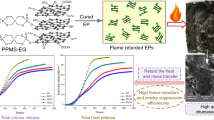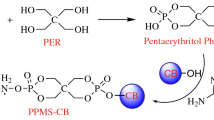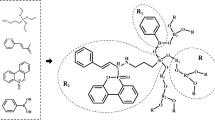Abstract
For effectively balancing the mechanical properties and flame resistance of intumescent flame-retardant epoxy resin (EP), the flame-retardant EPs were prepared to explore the synergistic effect of expansible graphite (EG) and bismuth oxide (Bi2O3) on traditional intumescent flame retardant (IFR). The results demonstrate that IFR-EG-Bi2O3 system has better flame resistance effect than IFR-EG or IFR-Bi2O3 system. Especially, 27 wt% IFR, 1.5 wt% EG and 1.5 wt% Bi2O3 endows EP with a limiting oxygen index (LOI) value of 28.7% and a UL94 V−0 rating, while 30 wt% IFR only imparts a LOI of 26.1% and a UL94 V−2 rating to EP. Moreover, the total heat release (THR) and total smoke release (TSR) of EP/IFR-EG-Bi2O3 composite are decreased by 18.3% and 45.0% compared to EP/IFR system. The enhanced thermal stability of EP/IFR-EG-Bi2O3 is attributed to the combination of EG and Bi2O3 that favors the retention of large amounts of aromatic structures in condensed phase. Meanwhile, replacing 3.0 wt% IFR with EG and Bi2O3 can effectively reduce the negative impact on EP matrix and achieve a better balance between mechanical properties and flame retardancy of intumescent flame-retardant EP due to the good interfacial adhesion between EG and EP and the crosslinked points formed by Bi2O3 and EP molecule.







Similar content being viewed by others
Data availability
The data that support the findings of this study are available from the corresponding author upon reasonable request.
References
Yazdanfar A, Shahrajabian H (2021) Experimental investigation of multi-wall carbon nanotube added epoxy resin on the EDM performance of epoxy/carbon fiber/MWCNT hybrid composites. Int J Adv Manuf Tech 116:1801–1817. https://doi.org/10.1007/s00170-021-07593-3
Jiang YP, Liu L, He GH et al (2023) A crosslinked organic/inorganic functionalized graphene containing hybrid engineering to improve the flame retardancy of epoxy resin. J Polym Res 30:144. https://doi.org/10.1007/s10965-023-03500-4
Yang QS, Wang J, Yang S et al (2023) A phosphoruscontaining aliphatic amine curing agent towards intrinsic flameretardant and smokesuppressive epoxy resins. J Polym Res 30:51. https://doi.org/10.1007/s10965-023-03437-8
Yi L, Long MT, Yan L et al (2023) A facile strategy to construct multifunctional microencapsulated urea ammonium polyphosphate for epoxy resins towards satisfied fire safety, thermal stability and compatibility. J Appl Polym Sci 140:e53675. https://doi.org/10.1002/app.53675
Xu YX, Nie SB, Dai GL et al (2022) Effect of phosphorus-modified nickel phyllosilicates on the thermal stability, flame retardancy and mechanical property of epoxy composites. J Polym Res 29:10. https://doi.org/10.1007/s10965-021-02843-0
Wang FY, Liao JH, Long MT et al (2023) Facile synthesis of reduced-graphene-oxide-modified ammonium polyphosphate to enhance the flame retardancy, smoke release suppression, and Mechanical Properties of Epoxy Resin. Polymers-Basel 15:1304. https://doi.org/10.3390/polym15051304
Xu ZS, Chu ZY, Yan L et al (2019) Effect of chicken eggshell on the flame-retardant and smoke suppression properties of an epoxy-based traditional APP-PER-MEL system. Polym Compos 40:2712–2723. https://doi.org/10.1002/pc.25077
Bai G, Guo CG, Li LP (2014) Synergistic effect of intumescent flame retardant and expandable graphite on mechanical and flame-retardant properties of wood flour-polypropylene composites. Constr Build Mater 50:148–153. https://doi.org/10.1016/j.conbuildmat.2013.09.028
Chen C, Zhou Y, He WD et al (2020) Flammability, thermal stability, and mechanical properties of ethylene-propylene-diene monomer/polypropylene composites filled with intumescent flame retardant and inorganic synergists. J Appl Polym Sci 138:e50116. https://doi.org/10.1002/app.50116
Zhang JF, Liang ZL, Liu JX et al (2022) Preparation and performance analysis of palygorskite reinforced silicone-acrylic emulsion-based intumescent coating. Prog Org Coat 166:106801. https://doi.org/10.1016/j.porgcoat.2022.106801
Yan L, Xu ZS, Wang XH et al (2018) Preparation of a novel mono-component intumescent flame retardant for enhancing the flame retardancy and smoke suppression properties of epoxy resin. J Therm Anal Calorim 134:1505–1519. https://doi.org/10.1007/s10973-018-7810-x
Lv P, Wang Z, Hu Y et al (2008) Effect of metallic oxides in polypropylene composites containing melamine phosphate and pentaerythritol. Plast Rubber Compos 37:311–318. https://doi.org/10.1179/174328908X314325
Xu ZS, Jia HY, Yan L et al (2020) Synergistic effect of bismuth oxide and mono-component intumescent flame retardant on the flammability and smoke suppression properties of epoxy resins. Polym Adv Technol 31:25–35. https://doi.org/10.1002/pat.4744
Wu N, Yang RJ, Hao JW et al (2009) Synergistic effect of metal oxides on intumescent flame-retardant PP systems. Acta Polym Sin 12:1205–1210
Jagdale P, Salimpour S, Islam MH et al (2018) Flame retardant effect of nano fillers on polydimethylsiloxane composites. J Nanosci Nanotechno 18:1468–1473. https://doi.org/10.1166/jnn.2018.15251
Xu ZS, Jia HY, Yan L et al (2020) Synergistic effects of organically modified montmorillonite in combination with metal oxides on the fire safety enhancement of intumescent flame-retarded epoxy resins. J Vinyl Addit Techn 27:161–173. https://doi.org/10.1002/vnl.21793
Yuan BH, Hu Y, Chen XF et al (2017) Dual modification of graphene by polymeric flame retardant and Ni(OH)2 nanosheets for improving flame retardancy of polypropylene. Compos Part A-Appl S 100:106–117. https://doi.org/10.1016/j.compositesa.2017.04.012
Yuan BH, Wang Y, Chen GQ et al (2021) Nacre-like graphene oxide paper bonded with boric acid for fire early-warning sensor. J Hazard Mater 403:123645. https://doi.org/10.1016/j.jhazmat.2020.123645
Si MM, Feng J, Hao JW et al (2014) Synergistic flame retardant effects and mechanisms of nano-Sb2O3 in combination with aluminum phosphinate in poly (ethylene terephthalate). Polym Degrad Stabil 100:70–78. https://doi.org/10.1016/j.polymdegradstab.2013.12.023
Yan L, Xu ZS, Jia HY et al (2020) Combination effect of organically modified montmorillonite and nano-silica on reducing the fire hazards of intumescent flame-retarded epoxy resins. J Vinyl Addit Techn 26:490–501. https://doi.org/10.1002/vnl.21764
Yi L, Yang Q, Yan L et al (2022) Facile fabrication of multifunctional transparent fire-retardant coatings with excellent fire resistance, antibacterial and anti-aging properties. Prog Org Coat 169:106925. https://doi.org/10.1016/j.porgcoat.2022.106925
Xu ZS, Deng N, Yan L et al (2018) Functionalized multiwalled carbon nanotubes with monocomponent intumescent flame retardant for reducing the flammability and smoke emission characteristics of epoxy resins. Polym Adv Technol 29:3002–3013. https://doi.org/10.1002/pat.4420
Wang FY, Liao JH, Yan L et al (2021) Fabrication of diaminodiphenylmethane modified ammonium polyphosphate to remarkably reduce the fire hazard of epoxy resins. Polymers-Basel 13:3221. https://doi.org/10.3390/polym13193221
Yang AH, Deng C, Chen H et al (2017) A novel Schiff-base polyphosphate ester: highly-efficient flame retardant for polyurethane elastomer. Polym Degrad stabil 144:70–82. https://doi.org/10.1016/j.polymdegradstab.2017.08.007
Wang JS, Xue L, Zhao B et al (2019) Flame retardancy, fire behavior, and flame retardant mechanism of intumescent flame retardant EPDM containing ammonium polyphosphate/pentaerythrotol and expandable graphite. Materlals 12:4035. https://doi.org/10.3390/ma12244035
Mamani A, Ebrahimi M, Ataeefard M (2017) A study on mechanical, thermal and flame retardant properties of epoxy/expandable graphite composites. Pigm Resin Technol 46:131–138. https://doi.org/10.1108/PRT-11-2015-0112
Li WB, Peng M, Zhao XM et al (2022) Properties of Bi2O3/epoxy resin-coated composites for protection against gamma rays. J Ind Text 51:7545S-7568S. https://doi.org/10.1177/15280837211051102
Acknowledgements
This research work was financially supported by the National Natural Science Foundation of China (Grant No.52276143), the Key Research and Development Program of Hunan Province (Grant No. 2021SK2054), the Science and Technology Research and Development Program Project of China railway group limited (Grant No. 2021-Special-02), and the funding of Hunan Tieyuan Civil Engineering Testing Co., Ltd (Grant No. HNTY2022K07).
Author information
Authors and Affiliations
Corresponding author
Ethics declarations
Competing interest
Authors have no conflict of interest to declare.
Additional information
Publisher’s Note
Springer Nature remains neutral with regard to jurisdictional claims in published maps and institutional affiliations.
Supplementary Information
Below is the link to the electronic supplementary material.
Rights and permissions
Springer Nature or its licensor (e.g. a society or other partner) holds exclusive rights to this article under a publishing agreement with the author(s) or other rightsholder(s); author self-archiving of the accepted manuscript version of this article is solely governed by the terms of such publishing agreement and applicable law.
About this article
Cite this article
Yi, L., Long, M., Yan, L. et al. Combination of expansible graphite and bismuth oxide for simultaneously improving the thermal behavior, fire performance and mechanical property of intumescent flame-retardant epoxy resins. J Polym Res 30, 335 (2023). https://doi.org/10.1007/s10965-023-03718-2
Received:
Accepted:
Published:
DOI: https://doi.org/10.1007/s10965-023-03718-2




